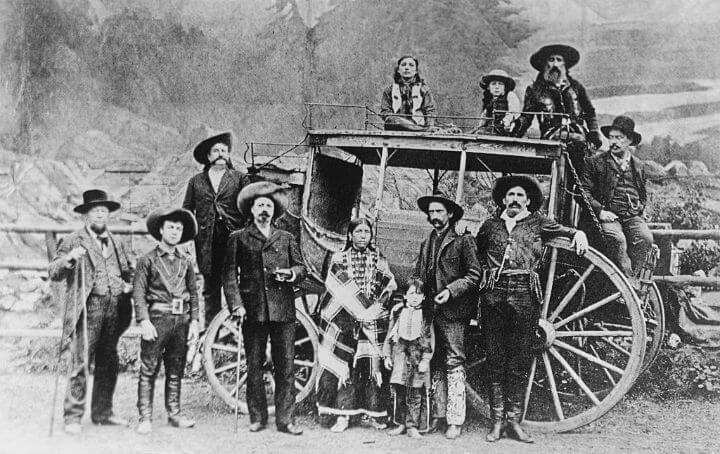Cowpoke Adventures During the Wild West
The Wild West Cowpoke Adventures
The Wild West alludes to the period from the finish of the Civil War in 1865 to around 1900.Cowpoke Adventures
It recounts the tales of the trailblazers, the pioneers, the dairy cattle lords, gold mining, rail lines and steamers, the cowpokes, Indians, criminals and gunmen.Cowpoke Adventures
Popular characters of the Wild West incorporate Whyatt Earp, Doc Holliday, Bat Masterson, Billy the Kid, Calamity Jane and Belle Starr.
After the main European pilgrims showed up in America, many move toward the west looking for another life and the guarantee of success.
The West offered land, great soil for cultivating and new chances to get rich that wasn’t possible in the East.
The Two-Fisted Town Tamer
Thomas James Smith, otherwise called “Bear River Smith” (12 June 1830 – 2 November 1870), was a lawman in the American Wild West and a marshal of dairy cattle town, Abilene, Kansas.
Smith was a calm expressed lawman with a tough standing who came from New York City, where he filled in as a cop.
While filling in as a cop in New York City in 1868, Smith was engaged with the unintentional killing of a fourteen-year-old kid, after which he surrendered.
He additionally filled in as a lawman in unassuming communities in Wyoming, Bear River and in Kit Carson, Colorado.
Marshal of Abilene
Abilene, Kansas, was a wild cows town with various cantinas, houses of ill-repute and rebellion.
From 1867, wrongdoing had expanded to where murder and shootings were a normal event.
Tom Smith was authorized as Deputy US Marshal to acquire peace and lawfulness to Abilene 1869 and demanded that he could implement the law by utilizing his clench hands rather than utilizing weapons.
Not long after getting down to business, Smith overwhelmed both, “Large Hank” Hawkins and “Wyoming Frank” and exiled them from Abilene, in the wake of beating them both simultaneously utilizing just his uncovered hands.
Smith likewise presented a “no firearms in as far as possible” law which was incredibly disliked.
Throughout the following two months, Smith endure two death endeavors.
His extreme standing and a few captures of crooks drove him to turn out to be generally regarded and respected by the residents of Abilene.
On the second of November, 1870, Smith and a brief agent went to serve a warrant to Andrew McConnell and Moses Miles about the homicide of another Abilene resident.
They found the presumes ten miles outside of Abilene where a gunfight emitted.
Smith was severely injured in the chest and his representative ran away from the area.
Moses Miles then, at that point, took a hatchet and beheaded Tom Smith.
McConnell and Miles were caught and captured in March 1871.
Andrew McConnell got 12 years in jail and Moses Miles burned through 16 years and delivered.
Tom Smith was covered in Abilene, and a tremendous headstone was raised with a plaque to respect his administration in Abilene.
Smith was supplanted as marshal by incredible lawman and gun slinger “Wild Bill” Hickock.
Ronald Reagan, as the host of the partnered western TV series, Death Valley Days, played Smith in the 1965 episode “No Gun Behind His Badge”.
Colter’s Run
John Colter (c.1770-1775 – May 7, 1812 or November 22, 1813) was a mountain man and pilgrim who was an individual from the Lewis and Clark Expedition of 1803 to 1806 appointed by President Thomas Jefferson, to investigate and plan the recently bought American Northwest from Napoleonic France, and past after the Louisiana Purchase of 1803.
Colter additionally turned into the primary individual of European plunge to enter the area which later became Yellowstone National Park and to see the Teton Mountain Range throughout the colder time of year of 1807-1808.
Blackfeet Indians
In 1809, Colter collaborated with John Potts, one more previous individual from the Lewis and Clark Expedition to snare for beaver for the worthwhile hide exchange close to the Jefferson River in what is currently Montana when they experienced a few hundred of the feared Blackfeet Indians while going by kayak.
The Blackfeet requested they come aground.
Colter agreed and was incapacitated and stripped exposed.
Potts denied and was shot and injured.
Potts then, at that point, killed one of the Indian fighters and was quickly loaded with bolts terminated by the Indians from the shore.
His body was then brought to shore and hacked to pieces.
Run-For-Life
After the Blackfeet thought how to kill Colter, the boss chose to permit him to run for his life and to be pursued by the Indians with lances.
They took him to a close by plain and gave him a three to 400 yard start.
Colter, realized that he should surpass the Blackfeet assuming he got any opportunity of making due.
He began his run-for-life across the plain and had dominated the Indians aside from one who was around twenty yards behind him.Cowpoke Adventures
Still up in the air to keep away from the normal lance toss, he abruptly halted, turned around, and spread out his arms.
The amazed Indian, excessively depleted from running, fell when he attempted to toss his lance.
Colter quickly grabbed up the lance and killed him then, at that point, proceeded with his run with the other Indians following a good ways off.
Colter arrived at the Madison River, five miles from his beginning, and stowed away under driftwood almost a beaver hold up.
He could hear the shouts of the Blackfeet, who turned upward and down the stream to track down him.
He held up till night, then, at that point, moved out and strolled totally bare and frozen, toward a merchant’s post.
Colter became more vulnerable from appetite and weariness, getting through just on roots and bark and had bloodied feet from thorny desert flora thistles penetrating his feet.
Inexplicably, Colter arrived at Manuel Lisa’s Fort inside seven days where he was welcomed by his companions.
Following half a month when he recovered his solidarity, he went to Blackfeet country that colder time of year to gather the snares he had abandoned.
John Colter resided five additional years after his inconceivable run, passing on from jaundice in Missouri, where he lies in a plain grave.
Alexander Todd
Previous representative, Alexander Todd got gold fever in this way, he went to California to look for his fortune.
He before long understood that he didn’t have the actual endurance to bear the backbreaking work at the gold fields in the freezing waterways of the Mother Lode (rich wellspring of a metal or mineral).
In any case, it didn’t take him long to track down amazing chances to bring in cash without searching for gold.
California Gold Rush
California had developed quick with the gold rush that getting a letter from San Francisco to the Mother Lode nation was troublesome.
The national government was delivering mail to California via the Isthmus of Panama, a course that was as extensive and dubious for the mail administration as it was for the Forty-Niners (gold searchers in the California dash for unheard of wealth of 1849).
Todd scoured the mining camps and joined many forlorn diggers who longed for word from home.
The closest mail center was in San Francisco which was a fourteen day trip there and back.
The excavators couldn’t leave their case that long so they pursued the mail administration.
On July 14, 1849, Todd started conveying mail to the San Francisco mail center charging $2.50 a letter and an ounce of gold, $16 for individual conveyance of any mail that he found for addresses in the mining camp.
On his first outing, he conveyed $150,000 in gold for certain vendors to an organization in San Francisco and was paid $7,500.
Whenever Todd gave the agent at the San Francisco mail center the extensive rundown of names, the representative confirmed Todd as a postal assistant so he could look through the heaps of letters himself charging a quarter for each letter he found.
That didn’t trouble Todd since he had found one more method for bringing in cash.
He purchased old New York papers for a dollar each and sold for $8 back at the gold fields.
Another lucrative business he presented was pressing gold from the mining camps to store in San Francisco in return for five percent of its worth.
All that he Did Turned to Gold
Without contacting a pick or a digging tool, Alexander Todd made a fortune utilizing old fashioned American resourcefulness.
Charles Marion Russell (1864 – 1926)
Charles Marion Russell, “the cowpoke craftsman,” narrator and creator (otherwise called C. M. Russell, Charlie Russell, and “Child” Russell) was brought into the world in St. Louis, Missouri on March 19, 1864.
He was a craftsman of the American Wild West who made in excess of 4,000 masterpieces during his lifetime, working in paint, bronze, ink, and wax of cowpokes, Indians, and scenes, set in the Western United States and in Alberta, Canada.
Russell adored the “Wild West” and would go through hours finding out about it and delighted in addressing pilgrims and hide brokers who came through Missouri.
He figured out how to ride ponies at Hazel Dell Farm close to Jerseyville, Illinois, on a well known Civil War horse named Great Britain from Col. William H. Fulkerson, who had hitched into the Russell family.
At sixteen years old, Russell passed on school to follow his fantasy of the Wild West as a cowpoke on a sheep farm in Montana then, at that point, continued on to work with Jake Hoover, a tracker and catcher who had turned into a farmer.
From Hoover, he found out much with regards to life in the Wild West and they stayed long lasting companions.
In 1882, at eighteen years old, Russell filled in as a cowpoke for various outfits in Montana.
It was in 1885 when he started to fill in as a craftsman.
Throughout the colder time of year of 1886-1887 while dealing with the O-H Ranch in the Judith Basin of Central Montana, he painted various watercolors.Cowpoke Adventures
Whenever the farm foreman got a letter from the proprietor, asking how the steers had endured the colder time of year he sent a postcard-sized watercolor that Russell had painted of a fatigued cow being preyed by wolves under a desolate winter sky.Cowpoke Adventures
The farm proprietor showed the postcard to companions and business colleagues and ultimately it was shown in a shop window in Helena, Montana providing Russell with his first taste of exposure and to getting commissions for new work.Cowpoke Adventures
His watercolor, “Sitting tight for a Chinook”, became one of his most popular works.
Local American Culture
In 1888, Russell acquired important information on Native American culture when he invested energy with the Blood Indians, a part of the Blackfeet.Cowpoke Adventures

